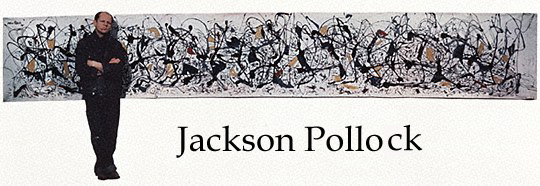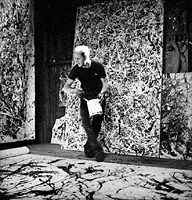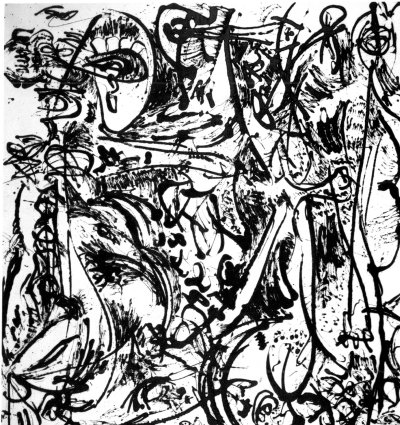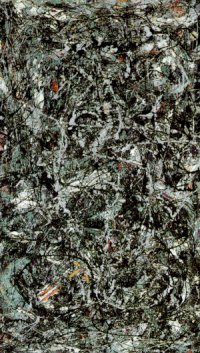|
Epigonen |
|
Jackson |
|
Epigonen |
|
Jackson |
|
Autoren gesucht / Künstler gesucht Englische / Amerikanische Künstler Englische / Amerikanische Schriftsteller Ausstellung Photos: Frank Kretschmer Anthologie Gedichte: Frank Kretschmer Links Zu Englischen und Amerikanischen Zeitungen, Museen, TV Sendern, und und und... ViSP - Impressum
|

- Einführung
- Bilder
- Bericht aus der WAZ zur Pollock Austellung in
Düsseldorf 1999
- Newsweek Artikel zur Retrospektive im MoMa 1999
 Ein Wort
vorweg: Ich habe mich bis jetzt damit schwer getan, Pollock auf dieser Seite
vorzustellen. Nicht, weil mir seine Werke nicht gefallen, im Gegenteil: Pollock ist einer
meiner erklärten Lieblingskünstler. Aber seine Bilder, die im Original von einer
unglaublichen Präsenz und Wucht geprägt werden (wie eigentlich alle Bilder der
Abstrakten Expressionisten), verlieren so unheimlich in solch einer kleinen Reproduktion.
Ein Wort
vorweg: Ich habe mich bis jetzt damit schwer getan, Pollock auf dieser Seite
vorzustellen. Nicht, weil mir seine Werke nicht gefallen, im Gegenteil: Pollock ist einer
meiner erklärten Lieblingskünstler. Aber seine Bilder, die im Original von einer
unglaublichen Präsenz und Wucht geprägt werden (wie eigentlich alle Bilder der
Abstrakten Expressionisten), verlieren so unheimlich in solch einer kleinen Reproduktion.
Aber in diesem Monat kommt man um ihn einfach nicht herum: Das MoMA in NY hat eine
umfassende Pollock Retrospektive veranstaltet, und wieder ist dieser Ausnahmekünstler in
aller Munde. So also auch hier. Außerdem nimmt mir das einige Arbeit ab: Denn anstatt mir
selber etwas aus den Fingern saugen zu müssen, füge ich einfach den hervorragende Artikel aus der Dez/Jan. Ausgabe (1/99) des Newsweek
Magazines an. Der enthält so ziemlich alles Wissenswerte über sein Werk. Hier aber
erst eimal wie gewohnt zwei Arbeiten.
Und nicht vergessen auch mal auf der Internetseite des MoMA vorbeizuschauen.

Echo No. 25 (1950), Enamel Paint on Canvas, 233 x 218 cm.

Full fathom five.(1950) Oil on Canvas with keys. ciggarets, matches, ect. 129 x 26.5 cm.
Der Titel ist eine Anspielung auf Shakespeares Sturm: "Full fathom five your father
lies and those are pearls that were his eyes." Darin wird der Tod des Vaters in der
See beschrieben. Diese Idee spiegelt sich in der Für Pollok ungewöhnlichen Farbgebung
wieder. (Kre.)
Newsweek Artikel:
ART: The show of the year tried to separate the myth of Pollock as the tormented soul from
the radical beauty ofhis paintings. And it gave him his place in the pantheon. BY PETER
PLAGENS
By the time Jackson Pollock came along almost all the basic ways of putting paint on a picture had been discovered. The 19th century impressionists had pracfically exhausted stippling. Brushy expressionism had been pre-empted by some Germans just before World War 1. Kasimir Malevich trotted out a blank-looking, white-on-white canvas in Russia in 1918. The territory of neat, flat colored reetangles was claimed by Mondrian in the 1920s. And since the early '30s, Salvador Dali had enjoyed a virtual lock on smoothly detailed surrealism. Nevertheless, Pollok found an empty slot and set up shop: he dripped — or poured or splattered—his paint. True, a few artists had occasionally produced drip paintings before Pollock did. But Pollock was the first to make dripping his entire, ongoing method. His signature style became instantly recognizable (Life magazine famously asked in 1949, ,,Is he the greatest living painter in the United States?“), and Pollock spent the years 1947 to 1951 devoted to it.
Pollock, without doubt, was a man of stunninginnovation. But 5Oyears on, a question
remains: is there enough visual pleasure in his best work to convince us that he was also
a genuinely great artist who belongs in the same pantheon as, say, Rubens and Manet?
Pollock painted at least a half-dozen large-scale masterpieces—“Number 32,“
,,Lavender Mist“ and ,,Autumn Rhythm“ (all from 1950) among them—that you
can admire whith your eye and heart as well as your brain. They're memorable compositions
and profoundly gorgeous paintings The late dripper ,,Blue Poles“ (1952), on loan from
Australia, is a knock - out. These pictures are what make Pollock‘s big
retrospective at the Museum of Modern Art in New York (through Feb. 2) the most important
show of the year. We confess we actually liked the Mark Rothko exhibition (which opened at
the National Gallery in Washington earlier this year better. Whereas Pollock‘s
creations leap farther forward, Rothko‘s meditative stiliness is more deeply
soothing. But emphatically yes, Pollock does belong in the pantheon.
Of course, there‘s more to Pollock than simply his work. He was part of the heroic effort of the abstract expressionists to liberate American painting not only from the provincial, homespun realism of Grant Wood and Thomas Hart Benton (Pollock‘s mentor) but also from what they considered the effete, small-scale modernism of the school of Paris. lt‘s not much of an understatement to say that Pollock, more than any other painter, helped move the headquarters of modern art from Europe to America. Pollock‘s comet also arrived at a time when New York was unarguably the greatest city on earth, a place where the best of the best and most daring of the daring could really shine. ,,Death of a Salesman“ and ,,A Streetcar Named Desire“ helped create world-dass theater on Broadway. In Brooklyn, Jackie Robinson made baseball a game for everybody. Norman Mailer‘s first novel, ,,The Naked and the Dead,“ redefined American literature. And Charly Parker, Dizzy Gillespie and Miles Davis led a renaissance in jazz. Pollock himself may not have cared for be-bop, preferring swing instead, but his drip paintings fit right in with it. Half a century later, with the mounting of the most extensive Pollock show ever, a symmetry is apparent. New York is booming again. Although serious theater, complex jazz and cutting-edge art may not yet equal the brilliance of the late ,40s and early ,50s, the conditions for a major revival seem present. Crime is down, Wall Street is up, and some truly adventurous people think that teeming, immigrant-rich Gotham is once again the place to fly.
The problem is that Pollock the man — or, really, Pollock the myth — can cloud our appreciation of his work. His lifelong battle with booze and his history of sociopathic outbursts (peeing in Peggy Guggenheim‘s fireplace, overtuming a fully laden dinner table, various barroom punch-ups) give rise to the suspicion that bis achievement might have been a sort of desperate accident. And his sudden death — in a drunken car crash in 1956, at the age ofjust 44 — lends a James Dean-like aura to his life.
MoMA‘s answer to the question of greatness, in the show‘s catalog essays, is to carefully downplay Pollock‘s troubled soul. Because ,,Pollock often gets cast as the last action hero, a ,natural‘ beat bobemian and a bastion of tortured purity and authenticity,“ writes curator Kirk Varnedoe, ,,it gets hard to demarcate cause from effect, image from reality.“ Yet in spite of what the catalog says, the museum‘s marketing campaign sells Pollock the man. One ad shows a still from the famous 1951 Hans Namuth film, shot through a sheet ofglass on which Pollock's painting, bis brow furrowed with intense concentration. Another has him posed in a T shirt in front of a drip painting, like a Method actor about to emote. (The museum also wants to avoid the overly dry interpretation of Pollock, espoused by the late critic Clement Greenberg, that has him painting as if in a laboratory, trying to resolve spatial problems left over from cubism.) In fact, there‘s good reason to play up Pollock the moody man. His whole life was a catharsis; his art looks cathartic; it is cathartic.
In the generations since Pollock died, hordes of other artists have tried to invent, or reinvent, new ways of handling paint.They‘ve shot bullets into pods containing the stuff and let it bleed down the canvas. They‘ve sprayed it on with airbrushes, piled it on inches tbick with trowels, scraped it down and slashed the canvas. They‘ve sanded their way through dried layers of it, and smeared nude models with it and bad them squirm around on canvases on the floor. They‘ve even indulged in oversize spinpaintings, the kind your kidmakes at the grammar-school fair. But none of them has had the impact Pollock had. Part of that is due to Pollock‘s talent, but anotherpart is due to the cultural moment. When Pollock first dripped, the most outrageous cultural phenomena were Mailer‘s soldiers muttering ,,fug.“ Today we‘ve got everything from semen jokes in ,,There‘s Sometbing About Mary“ to performance artist Ron Athey‘s cutting anotber man onstage and making ,,prints“with the blood. These days you‘vegot to splatter body fluids, not just paint, to shock anyone.
In today‘s overpopulated, media-obsessed art world, tbe hottest new artists are slacker painters who crank out quick, vacuous portraits of supermodels, and photographers who tart up fashion shoots with bondage. Their ,,daring“ amounts to being merely trendy. As for the bohemian deprivation that Pollock suffered until fairly late in bis career, a recent Columbia University study of artists in four major American cities reveals that half have retirement plans, and 8O percent health insurance. And the famous ones appear in Gap ads and direct Hollywood movies. It‘s hard to imagine Pollock in this crowd. On the other hand, Pollock himself would likely be celebrated today for overcoming an absent father, struggling with alcoholism and laboring outside the modern art mainstream (that is, lOOmiles from Manhattan, in a glorified Hamptons shed). In the touchy - feely‘90s, he‘d be looked up to mostly for “addressing the issue of identity“ because, as the catalog notes, he “repeatedly tried to reinvent bimself.“
The black-tie dinner for the Pollock opening at MoMA in the fall was the most packed and excited in years. The likes of comic genius Steve Martin and real-estate baron Mortimer Zuckerman sbowed up to hobnob witb a mob of curators, trustees and other collectors. The congratulatory speeches had the euphoric ring of the pulpit, and the diners had the gospel bounce of a congregation at Easter. Pollock, of course, was present in spirit only. Were he alive, be might not have been invited, given bis tendency to get drunk and flip tables. And maybe he would have been too disturbed to behave well. He would have seen what inevitably happens to great modern art born from an artist‘s struggle with bis personal demons. It becomes trophies for the rich and then, after a decent interval, public attractions on the cultural tourism trail. But if that didn‘t happen, Pollock‘s paintings wouldn‘t be in public for us to applaud.And applause, as Aristophanes said, is what artists want. A little urine in tbe ashes aside, Pollock would have been delighted to take a well-deserved bow.
Artikel aus der WAZ vom 19.7.1999
Die Ruhe und der Sturm
Werke von Jackson PoIIok in der Kunstsammlung NRW
Daß Künstler auf Leinwand malen, scheint normal. Bei Jackson Pollock war es jedoch wörtlich zu verstehen. Er stellte sich auf seine Bilder, verteilte die Farbe mit Gießkanne und Stock. Was dabei herauskam, zeigt eine Ausstellung In Düsseldorf.
Eines der kraftvollsten Pollock-Bilder, das übervier Meter messende Werk ,,Nummer 32", befindet sich im Besitz der Kunstsammlung NRW. Um dieses Werk herum gruppiert das Museum eine Ausstellung mit rund 50 Bildern, die aus dem New Yorker Museum of Modem Art und europäischen Sammlungen stammen.
Die Schau zeigt, aus wievielen Quellen Pollock (1912-1956) schöpfte. Da finden sich Anklänge an die europäische Malerei (z. B. an Paul Klee, den Kubismus oder den Automatismus der Surrealisten) und an die amerikanische Volkskunst. Zwarnichtdieanklagendepolifische Botschaft, dafür aber die Monumentalität der Bildformate übernahm Pollock von den Südamerikanern. Dabei
setzte Pollock weniger aut Diego Rivera denn auf Siqueiros, in dessen Kunst-Laboratorium er auch Techniken wie das ,,Dripping" (Farbtröpfeln) lernte.
Die Beziehung zwischen Siqueiros und Pollock hat bereits 1995 eine Ausstellung in der Kunsthalle Düsseldorf beleuchtet. Konsequent ist es, daß sich jetztauch diegegenuberliegende Kunstsammlung mit Pollocks Werk beschäftigt.
So krass, wie ,,Jack die Dripper" - bei allen Anleihen - mit der Tradition brach, um dieamerikanische Nachkriegskunst aus dem Schatten der europäischen zu ziehen, so heftig war er auch in seinen persönlichen Auftritten. Zwischen Euphorie, Aggressivität und Depression fuhren seine Gefühle Achterbahn. Gleichmäßig hoch war nur sein Verbrauch an Zigaretten und Alkohol.
Irgendwie erinnerte der eigenwillige Typ in seiner Jeans Ausstattung an einen der letzten Cowboys. Und daß er mit
dem Auto in den Tod raste, läßt unwillkürlich an James Dean denken, der ebenfalls für sein Außenseitertum bekannt war. Berühmt waren natürlich Dean und Pollock schon zu Lebzeiten, unzweifelhaft waren beide Meister ihres Fachs. Dennoch:
Der frühe Tod nährte die Legendenbildung.
Doch statt hier Anekdoten über Pollocks Auftritte in Wildwest-Manier wiederzubeleben, soll noch einmal auf sein Werk geschaut werden: In Pollocks stärksten Bildern werden vor allem zwei Richtungen sichtbar. Zum einen tobt sich die ungestüme Seite des Künstlers aus. Wuchtige schwarze Knotenpunkte, verbunden durch wilde Linienschwünge, kennzeichnen z . B. ,,Nummer 32".
Zum anderen zeigt sich die sensible Seite Pollocks. Ganz feine Liniengeflechte und delikate Farbtupfer prägen Bilder wie ,,Nummer 1 A" oder ,,Widerschein des Großen Bären". Wenn man diese Bilder sieht, weiß man, was es heißt, aus dem ,,Unterbewußten" zu malen.
Michael Vaupel